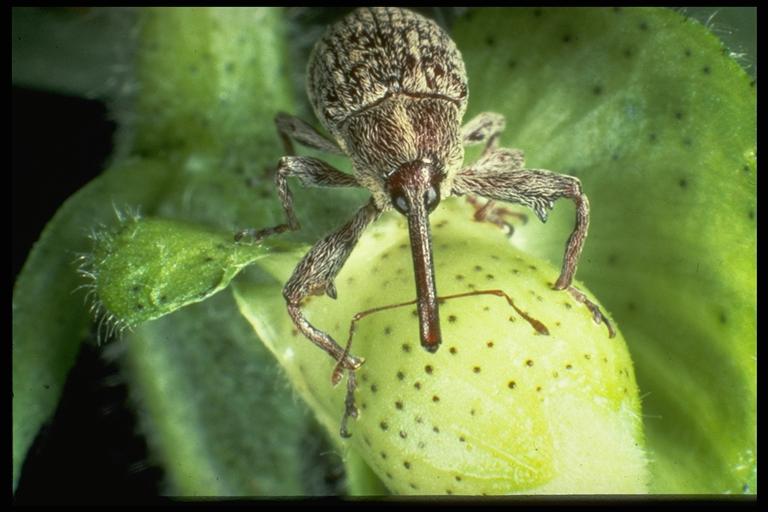
Boll weevil, Anthonomous grandis Boheman (Coleoptera: Curculionidae). Photo by W. Sterling.
Common Name: Boll weevil
Scientific Name: Anthonomous grandis Boheman
Order: Coleoptera
Description: The adults are brown to grayish brown, fuzzy beetles with prominent snouts (or bills) bearing the mouthparts, and varying in size from 1/8 to almost ½ inches long. Larval stages, found inside cotton squares and bolls, are legless grubs with brown heads that grow to about ½ inch long before forming a pupa that resembles the adult features but appears mummy-like.
Some other agriculturally important weevils include the pepper weevil, Anthonomus eugenii Cano, and the apple curculio, Tachypterellus quadrigibbus (Say).
Life Cycle: Adults overwinter, or “diapause,” in leaf litter and fly to cotton fields in the spring. After feeding for 3 to 7 days, weevils mate and females lay eggs in cotton squares (flower buds) or bolls (fruit) that are 1/4 inch or more in diameter.
Larvae hatch in 2 ½ to 5 days, and larvae feed for 7 to 14 days and develop through several stages (instars) before pupating. Adults emerge in 4 to 6 days and chew their way out of the cotton square or boll in which they developed. Development from egg to adult can be completed in 16 to 18 days. Six or seven generations can be produced each year.
Habitat and Food Source(s): Mouthparts are for chewing. This insects feeds and develops only in cotton and closely related tropical (malvaceous) plants. Adults weevils feed on tender cotton terminals in the spring, pollen in cotton squares (flower buds) and bolls (fruit). Weevils drill holes into the squares or bolls with their chewing mouthparts at the tip of their “snout” (rostrum). Some of these feeding sites are used to lay eggs in by the females. After inserting the egg into the feeding puncture, she secretes a sticky substance that covers the cavity that hardens and forms a wart-like blemish. Feeding punctures do not have this wart-like blemish. Infested cotton squares or bolls turn yellow and falls off the plant. Larger infested bolls may not drop, but cotton lint developing in these bolls is damaged. Heavily infested cotton may produce much foliage but few mature bolls. The pink bollworm, Pectinophora gossypiella (Saunders) (Lepidoptera: Gelechiidae) also has larva found in cotton bolls. These caterpillars can be distinguished by their color ad the presence of legs. Adults and immatures can be found in or reared from cotton fruiting structures.
Pest Status, Damage: Caused major changes in cotton production practices since it migrated into and across Texas and the southern states (1892-1920’s); larvae feed in cotton squares and bolls; medically harmless.
For additional information, contact your local Texas A&M AgriLife Extension Service agent or search for other state Extension offices.
Literature: Bohmfalk et al. 1982; Metcalf et al. 1962.